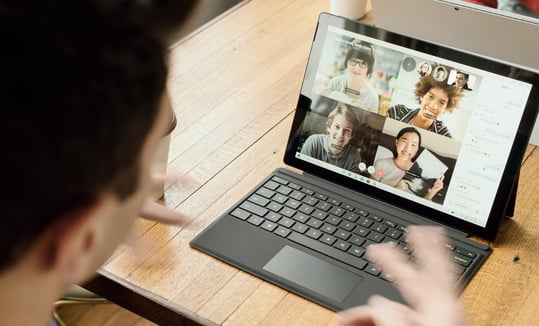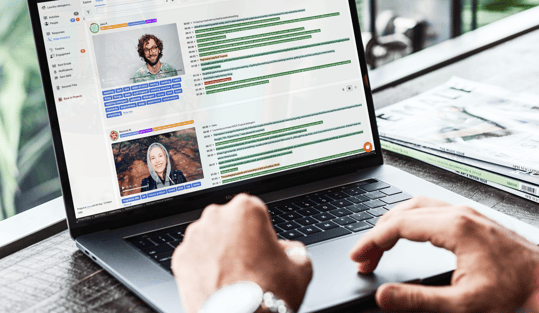The 3 Market Research Trends Taking The Industry By Storm

Contents
Market research trends tend to change gradually over time, with the changes often starting in a particular market before becoming global trends. The nature of the global economy is that eventually most market researchers around the world will eventually be affected by these trends, but the direct impact on how they work may be quite minimal (at least initially).
We live in a world right now, however, where the speed of change is being forced upon a market research professional is much faster than normal. Remote working has become much more common, and all manner of research (for example - tracking a customer journey) has had to be adjusted to consider new restrictions on practical aspects of conducting market research - particularly in terms of how data collection will need to be done.
While the effect of the pandemic has loomed large since 2020, the most important trends will remain long after temporary restrictions to how new data can be collected and what data sources are available have been lifted.
There is no turning back now, whether we like it or not, so understanding these trends is more important than ever.
Major Market Trends
The key market research trends I want to talk about in this article are happening in the industry primarily due to behavioural changes - particularly due to the limits on physical research (such as focus groups) in 2020 and 2021 - and technological changes.
These trends are strongly related to each other, causing a "ripple effect" that has pervaded the entire industry.
Each of these research trends influences and magnifies the next:
- The accelerated move to online research
- The unstoppable rise of Video
- The rise of automated analytics in qualitative research

The accelerated move to online research
Online market research is as old as the internet itself. As with everything on the internet, it has grown in capability and complexity over the years to become an extremely important method of data collection for the market research industry.
The sheer power of the internet for data collection has meant that anything that can benefit from the huge data sets that can be accessed online has grown through the years. The best example of this is the quantitative data that can be collected in online surveys. Nothing can compete with the ability of a Web Survey platform to get quick insights from large groups of people at scale.
Online research has primarily grown through the use of technology to add to the existing research methods in ways that can not be replicated in the "real world". Huge scale, the ability to leverage social media, and the ability to crunch a lot of data are just some of the things that have made certain online research methods so important for literally decades.
The (temporary?) fall of in-person research
 Participants have become accustomed to taking part in groups on Zoom or other video conferencing systems. There was no travel time or cost, and it was less of a "hassle" to agree to take part. Group rooms did not need to be booked, and moderators could run groups of people who are geographically dispersed.
Participants have become accustomed to taking part in groups on Zoom or other video conferencing systems. There was no travel time or cost, and it was less of a "hassle" to agree to take part. Group rooms did not need to be booked, and moderators could run groups of people who are geographically dispersed.
Opportunities created by this trend
As an increasing slice of new projects moves online, the replacement for "in-person" will primarily be "on video". It will be easier to get participants (because being in the vicinity of a central location is no longer necessary, and attending virtually is less of a "hassle"), and moderator location is also unimportant. Incentives can be less, and some costs - like the cost of a group room - will disappear completely.
The market research industry as a whole would need to re-educate clients as to the limitations of the new approach, but the cost savings will be a big incentive for them to seriously consider the benefits of going online.
The move to online is both a key driver and a beneficiary of arguably the biggest of the market research trends occurring at this moment... the ever-increasing importance of video in any market research project - which leads us to the second major trend we need to talk about...
The unstoppable rise of Video
The collection of videos from participants has been growing in importance for years, and it is rare to see online market research projects nowadays that don't include a video component. This use of video in some capacity is not something new.
For quite a few years the novelty of just being able to collect video and watch it has been enough for market researchers because it was a great new way to get honest feedback and infer other details such as demographic data just by watching people. It was great to be able to get valuable insight online in a whole new way, and clients have loved it.

Video collection is now just the beginning
As with everything in life though, people start wanting more... and it has also become increasingly important for it to be faster and cheaper. Data collection for videos has had to become more than just "collect a video and watch it".
This need for more insights more quickly is no longer some niche requirement for a few projects. It is needed in all projects - regardless of whether they are about brand metrics, market trends, social listening or just simply collecting general opinions.
Understanding the bigger picture by including video as part of any research project is considered to be extremely important by clients who want to make informed decisions, understand the biggest trends and get a better understanding of what various different types of people think - regardless of whether they are looking at consumers online through, people using social media, employees of many companies or anyone else. Video is almost always a powerful tool to go beyond text-based responses.
 The market research data that is becoming more valuable to clients requires analysing the content from multiple videos at the same time. In general terms, the sorts of questions they want answers to from videos in a market research project are:
The market research data that is becoming more valuable to clients requires analysing the content from multiple videos at the same time. In general terms, the sorts of questions they want answers to from videos in a market research project are:
- What is everyone talking about?
- What do they like?
- What don't they like?
Opportunities created by this trend
Now is the time to sharpen your skills and bring together a set of tools that allows you to conduct research using video as a primary source of insights.
You need to be able to deal with video at scale and treat video just like any other research data, where the goal is to give your clients - be they brands, publications, academic institutions or other organisations dealing with consumers and customers - usable insights that will lead them to success.
The use of video provides a great opportunity to provide some amazing services to your clients, including:
- Use of social listening analysis to understand what participants are talking about, what they think, how they feel and what they need from your client.
- Discovering key themes that are important to participants.
- Finding and highlighting things that participants are particularly positive and negative about.
- Providing important clips and showreels to clients, by taking all the most important insights from all the videos and distilling them into a visual summary.
As the amount of video being collected grows, and the level of analysis and quality of expected outputs also becomes higher - this all begs the question... how is this even achievable? Watching hours and hours of video and trying to make sense of it all is extremely time-consuming, so manually solving this problem is expensive at best, and near-impossible at worst.
The solution is actually the final market research trend I want to discuss - The rise of automated analytics in qualitative research.
The rise of automated analytics in qualitative research
Large companies like Google have massive server farms that they are constantly leveraging to build ever more "intelligent" systems to translate, transcribe and interpret massive amounts of data. Huge competitors including IBM, Microsoft and Amazon are putting in similar efforts to develop their own systems.
The rise of machine learning and artificial intelligence throughout the market research industry has been occurring off the back of these systems for more than a decade, with quantitative research, in particular, taking advantage of these systems.
Products like Microsoft BI have grown into powerful tools used to run reports and surface insights based on huge amounts of data. Live dashboards have become the norm, and "crunching the data" is commonplace.
The use of machine learning and artificial intelligence has been less common in qualitative research, however, partly because there is less need to process a lot of data. This has meant human analysis is more feasible. Until recently, people have also questioned whether analysis like that needed in many projects (e.g. social listening projects) can be done by computer.
Market researchers also commonly sell themselves as the highly skilled professionals who read and analyse the qualitative data themselves as part of their service.
Automated analytics turn videos into valuable market research data
The big change that has occurred recently can be distilled down to a single word - Video. For all the benefits that video offers, there is one roadblock to any of the benefits... you actually have to watch and somehow process a video into useable market research data. This is an extremely laborious and time-consuming process that frankly most clients aren't going to be willing to pay for. They want the results, but not the costs.
 The best way to understand why automated analytics are so important for video is probably just to list some of the key benefits they offer. Imagine a world where:
The best way to understand why automated analytics are so important for video is probably just to list some of the key benefits they offer. Imagine a world where:
- What is said in a video is transcribed into near-perfect text
- Everything that is said can be searched, and key entities/themes are pulled out for you
- Positive and negative sentiment is determined for everything that is said
- Rather than watching or hunting through hours of video, you can say things like "show me everything positive that has been said about product x"
- Snippets of text can be extracted for written reports, and the video containing these snippets can be pulled together into a "showreel" that the client can watch

This world already exists - and it is the world made possible through video analytics. It has been made possible by taking the capabilities of Google, Microsoft, Amazon and others, and using them as building blocks to create a solution that is specific to market research.
There is a number of providers who have done just that. VoxPopMe was one of the earliest providers of these capabilities. More recently they have been joined by various other providers who have varying levels of support for Video Analytics, including Hatchtank and Further. The most recent provider of a full-featured Video Analytics system is Qualzy.

Opportunities created by this trend
If you can become adept at collecting video and processing it quickly and efficiently you can move to the forefront of one of the biggest trends in market research today. Video is one of those things that clients get excited about, and including a showreel as part of your presentation can add that extra level of "pizzazz" clients love.
The difference between a presentation that has been based on laborious viewing of videos and one that uses video analytics will be stark. The speed with which the latter can identify key themes and find the best comments is unmatched by manual methods.
So, the biggest opportunity is for you to use these new tools while your competitors don't. Making yourself look better than the competition is rarely so easy!
What's next for the Market Research Industry?
Like most things in life, the market research industry is constantly in a state of change. It's hard to say what the next trends will be in the industry, but I think it is fair to say that the trends I have talked about in this article are still in their early stages.
We're not there yet!
I don't think we are close to seeing the full effect of the move to online and the reliance on video - there is plenty of steam left in these trends before we have to worry about the next ones!